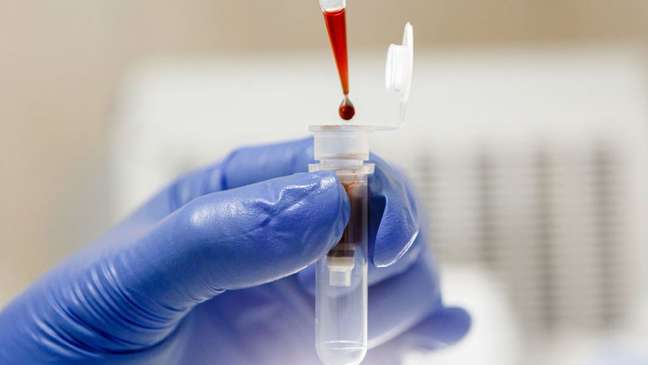Experts indicate that the technique, already used to monitor cancer patients, should in the future be able to diagnose cancer with a simple blood test.

A liquid biopsy primarily uses blood (although it may also use urine or other body fluids) to look for the presence of malignant cancer cells or DNA fragments of cancer cells.
“The test is so called to differentiate it from solid biopsy, in which a fragment of the tumor is taken and analyzed under a microscope, a more invasive technique”, explains Héber Salvador, cancer surgeon and president of the SBCO (Brazilian Society of Oncological Surgery). .
Currently, the test is used in some countries, including Brazil, although the technique is not yet widespread here, mainly to monitor patients who have already been diagnosed with cancer.
For example, it is possible to evaluate the effectiveness of a treatment (such as chemotherapy), and the possibility of relapse (cancer relapse) in a patient already in remission by analyzing the presence of cancer cells at the end of a treatment. Although it is already used for other types of cancer, its major use is in patients with colorectal cancer and lung cancer, as these are the most researched diseases that reinforce the advantages of the technique.
But according to experts interviewed by BBC News Brasil, the technique may offer much more in the future.
Through liquid biopsy, the same blood we take to check blood glucose and cholesterol levels should tell us, in the next few years, if we have cancer cells long before a tumor appears, as well as offer great information. specific for the type of cancer.
This would allow for early intervention, which for many cancers is the main determinant of treatment success.
With the help of industry experts, we have listed below the main downsides of liquid biopsy, what the exam already offers in terms of patient benefits, and what we can expect in the future.
Negative points
– Lack of reliability
Because the test is relatively new and has not yet reached its full technological potential, it ends up being used as a complementary form of screening.
“There is still no absolute certainty that the interpretation of the liquid biopsy corresponds exactly to what is happening in the tumors and in the person’s body,” explains Héber Salvador.
“We already have good evidence and research is growing, but I would say that, at the moment, the liquid biopsy does not give us the final word on whether or not a tumor exists, or that that patient is more likely to metastasize. tests must be done. ” she asked. ”
– Price and lack of accessibility
Depending on the indication of the test, the cost in the few laboratories where the test is available in Brazil ranges from six to fifteen thousand reais, according to Dr. Gabriela Félix, molecular geneticist and manager of the Precision Oncology Laboratory at Igenomix Brasil. The agreements do not cover the test.
“Compared to ten or even five years ago, the price has already decreased, even if it is still high. For many it is an impediment, but with the passage of time the technique tends to become better and cheaper”, adds Thiago Bueno. de Oliveira, clinical oncologist, president of the GBCP (Brazilian Head and Neck Cancer Group) and head of the ACCamargo Cancer Center.
Strengths
– Simplification of tracking
Instead of having to subject a cancer patient – who often already has compromised immunity – to a solid biopsy, a surgical procedure that removes a sample of the tumor, follow-up to assess whether the disease is regressing or not can be done using liquid biopsy. .
The technique is much less invasive and is beneficial in situations such as the covid-19 pandemic, as the patient does not need to be exposed to the hospital environment.
– Result time
Depending on the patient’s region, the laboratory services used, as well as the type of tumor resulting from a solid biopsy, explains geneticist Gabriela Félix, can take up to three months. “The liquid biopsy is ready in ten days, which facilitates the rapid initiation of treatment, especially for aggressive tumors.”
– Guide to the choice of treatment
“When we want to identify a specific mutation [que sabemos que responde melhor a determinados tratamentos]some of them appear in the bloodstream and the examination allows this identification, avoiding surgical interventions “, underlines the clinical oncologist Thiago Bueno de Oliveira.

For the future
“The malignant cells have the characteristic of falling into the bloodstream, which makes them able to settle elsewhere. And sometimes this happens very soon, before the tumor shows signs or the mass appears on imaging examination. Hence the possibility of an early diagnosis is open “, underlines the cancer surgeon Héber Salvador.
Early diagnosis increases the chances of survival for patients with different types of cancer. In the case of breast cancer, for example, discovery when the disease is still in an early stage is estimated to represent a 90% chance of remission.
In the United States, two diagnostic tests are being tested which could arrive on the market in the next two years. There is, however, no expectation that the exam will soon be covered by health plans.
Furthermore, it is expected that as the use of the technique advances there will also be improvements in the reading of exams, which allow easier reading even for non-specialist doctors.
– Originally published text https://www.bbc.com/portuguese/geral-62088413
Source: Terra
Benjamin Smith is a fashion journalist and author at Gossipify, known for his coverage of the latest fashion trends and industry insights. He writes about clothing, shoes, accessories, and runway shows, providing in-depth analysis and unique perspectives. He’s respected for his ability to spot emerging designers and trends, and for providing practical fashion advice to readers.


-1ibeskywkh3z8.png)




